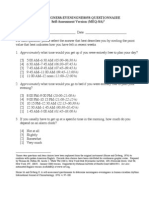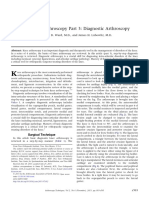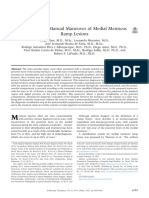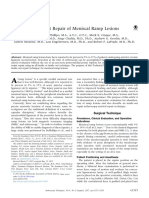0 ratings0% found this document useful (0 votes)
41 viewsBasic Knee Arthroscopy Part 2
Basic Knee Arthroscopy Part 2
Uploaded by
Diego BellingThis document provides guidance on surface anatomy landmarks and portal placement for knee arthroscopy. It discusses marking the patella, patellar tendon, tibial tubercle, medial and lateral joint lines, and head of the fibula as references. The anterolateral portal is placed just above the lateral meniscus and next to the patellar tendon. The anteromedial portal is created under direct visualization using a spinal needle to ensure it is just above the medial meniscus and can access the posterior horn. Accurate portal placement is critical for diagnostic and operative arthroscopy of the knee compartments.
Copyright:
© All Rights Reserved
Available Formats
Download as PDF, TXT or read online from Scribd
Basic Knee Arthroscopy Part 2
Basic Knee Arthroscopy Part 2
Uploaded by
Diego Belling0 ratings0% found this document useful (0 votes)
41 views2 pagesThis document provides guidance on surface anatomy landmarks and portal placement for knee arthroscopy. It discusses marking the patella, patellar tendon, tibial tubercle, medial and lateral joint lines, and head of the fibula as references. The anterolateral portal is placed just above the lateral meniscus and next to the patellar tendon. The anteromedial portal is created under direct visualization using a spinal needle to ensure it is just above the medial meniscus and can access the posterior horn. Accurate portal placement is critical for diagnostic and operative arthroscopy of the knee compartments.
Copyright
© © All Rights Reserved
Available Formats
PDF, TXT or read online from Scribd
Share this document
Did you find this document useful?
Is this content inappropriate?
This document provides guidance on surface anatomy landmarks and portal placement for knee arthroscopy. It discusses marking the patella, patellar tendon, tibial tubercle, medial and lateral joint lines, and head of the fibula as references. The anterolateral portal is placed just above the lateral meniscus and next to the patellar tendon. The anteromedial portal is created under direct visualization using a spinal needle to ensure it is just above the medial meniscus and can access the posterior horn. Accurate portal placement is critical for diagnostic and operative arthroscopy of the knee compartments.
Copyright:
© All Rights Reserved
Available Formats
Download as PDF, TXT or read online from Scribd
Download as pdf or txt
0 ratings0% found this document useful (0 votes)
41 views2 pagesBasic Knee Arthroscopy Part 2
Basic Knee Arthroscopy Part 2
Uploaded by
Diego BellingThis document provides guidance on surface anatomy landmarks and portal placement for knee arthroscopy. It discusses marking the patella, patellar tendon, tibial tubercle, medial and lateral joint lines, and head of the fibula as references. The anterolateral portal is placed just above the lateral meniscus and next to the patellar tendon. The anteromedial portal is created under direct visualization using a spinal needle to ensure it is just above the medial meniscus and can access the posterior horn. Accurate portal placement is critical for diagnostic and operative arthroscopy of the knee compartments.
Copyright:
© All Rights Reserved
Available Formats
Download as PDF, TXT or read online from Scribd
Download as pdf or txt
You are on page 1of 2
Basic Knee Arthroscopy Part 2: Surface Anatomy
and Portal Placement
Benjamin D. Ward, M.D., and James H. Lubowitz, M.D.
Abstract: Knee arthroscopy is an important diagnostic and therapeutic tool in the management of disorders of the knee.
In a series of 4 articles, the basics of knee arthroscopy are reviewed. In this article (part 2), surface anatomy and the
anterolateral and anteromedial portals are reviewed. Accurate portal placement is critical to both diagnostic and operative
arthroscopy. Mastery of the surface anatomy allows accurate and reproducible portal placement.
K nee arthroscopy is the most commonly performed
orthopaedic procedure. Indications include diag-
nostic arthroscopy, meniscectomy, loose body removal,
Surgical Technique
This article will review the relevant surface anatomy
as well as placement of the anterolateral and ante-
chondroplasty, microfracture, irrigation and debride- romedial portals (Fig 1). Beginning arthroscopists will
ment, and ligament reconstruction. In this series of arti- find it beneficial to mark out the surface anatomy as
cles, we present a comprehensive review of the complete a reference for portal placement. The palpable borders
surgical technique for basic knee arthroscopy.1,2 of the patella, tibial tubercle, and patellar tendon, the
Knee surface anatomy and portal placement are medial and lateral tibial joint line, and the head of the
reviewed in this article and Video 1. Accurate portal fibula are marked on the skin. Typically, the lateral joint
placement is critical to both diagnostic and operative line is slightly more superior than the medial joint line.
arthroscopy. Mastery of the surface anatomy allows The marks will give a reference for placement of the
accurate and reproducible portal placement. Proper arthroscopic portals. The anterolateral and antero-
placement of the anterolateral portal just superior to medial portals can be vertical or horizontal. Horizontal
the lateral meniscus and just lateral to the patellar portals are more cosmetic, but if they are placed too
tendon allows optimal visualization of the compart- high or too low, they may be difficult to correct, so the
ments of the knee and proper access for the operative beginning arthroscopist may prefer a vertical portal.
instruments. Proper placement of the anteromedial The superomedial portal is an optional portal typically
portal just superior to the medial meniscus but inferior used for fluid outflow. The anterolateral portal is placed
enough for instruments to reach the posterior horn of 1 cm above the joint line and just next to the patellar
the meniscus is also critical. tendon in a palpable soft spot. The anteromedial portal
is placed 1 cm above the joint line and 1 cm medial to
the patellar tendon, also in a palpable soft spot. The
placement of the anteromedial portal can be confirmed
From the Taos Orthopaedic Institute, Taos, New Mexico, U.S.A. with a spinal needle using the arthroscope.
The authors report the following potential conflict of interest or source of After marking, the portals are typically injected with
funding: B.D.W. receives support from Arthrex Fellows Forum Travel and a local anesthetic. A No. 15 or 11 blade with the blade
Hotel; J.H.L. receives support from SNE, Arthrex, Ivivi, AANA, law firms not facing away from the patellar tendon is used to make
related to the orthopaedic industry (i.e., medical malpractice defense, ski
a 4- to 5-mm portal. The skin and the joint capsule are
industry defense), Breg, Donjoy, Smith & Nephew, MTF, DCI, patents pending
with Arthrex not related to manuscript, Taos Orthopaedic Institute, Taos incised, with care taken not to damage the ligaments or
Center for Sportsmedicine and Rehabilitation, and Taos MRI. cartilage and to stay above the meniscus. The arthros-
Received June 29, 2013; accepted July 25, 2013. copic cannula with a blunt obturator is then brought
Address correspondence to James H. Lubowitz, M.D., Taos Orthopaedic into the field and held with the index finger along the
Institute, 1219-A Gusdorf Rd, Taos, NM 87571, U.S.A. E-mail: jlubowitz@
cannula. The cannula is inserted into the anterolateral
kitcarson.net
Ó 2013 by the Arthroscopy Association of North America portal at an angle parallel to the tibial plateau and
2212-6287/13439/$36.00 directed between the condyles. The cannula is then
http://dx.doi.org/10.1016/j.eats.2013.07.013 pushed into the intercondylar notch. This motion is
Arthroscopy Techniques, Vol 2, No 4 (November), 2013: pp e501-e502 e501
e502 B. D. WARD AND J. H. LUBOWITZ
Fig 2. Arthroscopic view, left knee, of medial compartment
Fig 1. Surface anatomy markings for a left knee: (A) patella, taken from the anterolateral portal. A spinal needle is used to
(B) patellar tendon, (C) tibial tubercle, (D) anteromedial determine the placement of the anteromedial portal. The
portal, (E) anterolateral portal, (F) fibular head, and (G) needle should enter the knee just superior to the medial
superior medial portal (optional portal for fluid outflow). meniscus and inferior enough to reach the posterior horn of
the medial meniscus.
repeated a few times to ensure that the cannula moves
freely through the portal and fat pad. Then, the cannula point, a beginning arthroscopist and even some ad-
is pulled back just enough to be outside of the inter- vanced arthroscopists will put a cannula into the portal.
condylar notch, the knee is straightened into full A hemostat can also be used to spread the portal to make
extension, and the cannula is advanced under the the passage of instruments easier.
patella into the suprapatellar pouch. The obturator is
removed, and the arthroscopic camera is locked into the Discussion
cannula. The fluid flow is then started, and the Knee arthroscopy is a valuable diagnostic and thera-
arthroscopic procedure is begun. Basic diagnostic and peutic procedure for the treatment of various knee
operative arthroscopy will be discussed in the subse- disorders. Precise placement of the anterolateral and
quent articles. anteromedial portals allows for full access to the
The anteromedial portal is the main working or compartments of the knee. A key point to remember in
instrumentation portal. The placement of this portal is marking the surface anatomy is that the lateral tibial
critical for effectively reaching the various intra-articular plateau is usually slightly superior to the medial tibial
structures with the arthroscopic instruments. It is rec- plateau. Marking the surface anatomy will facilitate
ommended to create this portal under direct vision using accurate placement of the portals. The anterolateral
the arthroscope. A spinal needle is inserted into the portal should be placed just superior to the lateral
medial compartment through the previously marked meniscus and close to the patellar tendon. The ante-
portal. The needle is held toward the tip so as not to romedial portal is the main working portal and there-
over-penetrate and damage the cartilage. The needle is fore should be placed under direct visualization to
inserted just above the meniscus. Under direct vision, ensure that the instruments will be able to reach the
the needle is advanced to touch the posterior horn of the posterior meniscus and other structures.
medial meniscus (Fig 2). If the entry angle is too high or
too vertical, the femur will prevent access to the poste-
References
rior structures. After an optimal position is found, the
1. Phillips BB. Arthroscopy of the lower extremity. In:
needle is removed and the No. 15 or 11 blade is used Canale ST, Beaty JH, editors. Campbell’s operative orthopae-
again to cut the skin approximately 5 mm. The knife dics. Ed 11. Philadelphia: Mosby Elsevier; 2008:2811-2893.
is then advanced, and an inline capsulotomy is per- 2. Aviles SA, Allen CR. Knee arthroscopy: The basics. In:
formed. Fluid escape from the portal is seen when an Wiesel SW, editor. Operative techniques in orthopaedic surgery.
adequate capsulotomy has been performed. At this Philadelphia: Lippincott Williams & Wilkins; 2011:248-256.
You might also like
- MEQ-SA Morningness-Eveningness QuestionnaireDocument7 pagesMEQ-SA Morningness-Eveningness Questionnaireadrucker100% (2)
- Basic Knee Arthroscopy Part 2: Surface Anatomy and Portal PlacementDocument2 pagesBasic Knee Arthroscopy Part 2: Surface Anatomy and Portal PlacementΗΛΙΑΣ ΠΑΛΑΙΟΧΩΡΛΙΔΗΣNo ratings yet
- Basic Knee Arthroscopy Part 3Document3 pagesBasic Knee Arthroscopy Part 3Diego BellingNo ratings yet
- Basics of Elbow Arthroscopy Part I: Surface Anatomy, Portals, and Structures at RiskDocument5 pagesBasics of Elbow Arthroscopy Part I: Surface Anatomy, Portals, and Structures at RiskMoustafa MohamedNo ratings yet
- Top Ten Pearls For Successful Hip ArthrosDocument10 pagesTop Ten Pearls For Successful Hip ArthrosMoustafa MohamedNo ratings yet
- Outside-In Capsulotomy of The Hip For Arthroscopic Pincer ResectionDocument6 pagesOutside-In Capsulotomy of The Hip For Arthroscopic Pincer ResectionMoustafa MohamedNo ratings yet
- Subtalar Arthrodesis Van Dijck 2012Document7 pagesSubtalar Arthrodesis Van Dijck 2012liviu tomoiagaNo ratings yet
- 4 in 1 Quadricepsplasty For Fixed and Habitual DisDocument8 pages4 in 1 Quadricepsplasty For Fixed and Habitual DisMinh ChíNo ratings yet
- AB. Artroskopik AnatomyDocument21 pagesAB. Artroskopik Anatomyİdrak MammadovNo ratings yet
- Arthroscopic Elbow Debridement Using Anterocentral Transbrachialis PortalDocument6 pagesArthroscopic Elbow Debridement Using Anterocentral Transbrachialis PortalMoustafa MohamedNo ratings yet
- Arthroscopic Ramp Repair No-Implant, Pass, Park, and Tie Technique Using Knee Scorpion, GustaDocument8 pagesArthroscopic Ramp Repair No-Implant, Pass, Park, and Tie Technique Using Knee Scorpion, GustaAlhoi lesley davidsonNo ratings yet
- Arthroscopy of The Wrist - Anatomy and TechniqueDocument4 pagesArthroscopy of The Wrist - Anatomy and TechniqueDiego Maté MartínNo ratings yet
- 9 Inside Out Meniscal Repair Medial and Lateral Approach 466525997Document6 pages9 Inside Out Meniscal Repair Medial and Lateral Approach 466525997Victor De Dios LunaNo ratings yet
- All Arthroscopic Anatomic Repair of An Avulsed Popliteus Tendon in A Multiple Ligamentinjured KneeDocument4 pagesAll Arthroscopic Anatomic Repair of An Avulsed Popliteus Tendon in A Multiple Ligamentinjured Kneechandan noelNo ratings yet
- Modified Anterior Portal For Hip Arthroscopy - 2013Document3 pagesModified Anterior Portal For Hip Arthroscopy - 2013cristobal ramosNo ratings yet
- State of ArtDocument8 pagesState of ArtJorge RealNo ratings yet
- Kansal 2011Document4 pagesKansal 2011Pushpraj ThakurNo ratings yet
- all inside and modified all inside of kneeDocument8 pagesall inside and modified all inside of kneevishalspatil1983No ratings yet
- LCP Técnica PreservaciónDocument6 pagesLCP Técnica PreservacióndrjorgewtorresNo ratings yet
- Arthroscopic Recognition and Repair or The Torn Subescapulari TendonDocument7 pagesArthroscopic Recognition and Repair or The Torn Subescapulari TendonNashNo ratings yet
- Diagnosis by Manual Maneuver of Medial Meniscus Ramp Lesions, Diego PiresDocument6 pagesDiagnosis by Manual Maneuver of Medial Meniscus Ramp Lesions, Diego PiresAlhoi lesley davidsonNo ratings yet
- Distal Clavicle Fracture Repair Using Cortical ButDocument5 pagesDistal Clavicle Fracture Repair Using Cortical ButSdgk KhaleelNo ratings yet
- PIIS2212628723002037Document5 pagesPIIS2212628723002037Jingguo ZhangNo ratings yet
- sicotj220020Document8 pagessicotj220020Marius ChirilaNo ratings yet
- Pi Is 2212628719300052Document7 pagesPi Is 2212628719300052Dr PavnishNo ratings yet
- Knee Textbook Arthroscopy-The-BasicsDocument19 pagesKnee Textbook Arthroscopy-The-BasicsDrManoj JagarlamudiNo ratings yet
- (Ii) Surgical Approaches To The Knee Joint: Anteromedial Parapatellar ApproachDocument8 pages(Ii) Surgical Approaches To The Knee Joint: Anteromedial Parapatellar ApproachDaniel G. A. C.No ratings yet
- Tibiotalocalcaneal Arthrodesis With Intramedullary Fibular Strut Graft and Adjuvant Hardware FixationDocument3 pagesTibiotalocalcaneal Arthrodesis With Intramedullary Fibular Strut Graft and Adjuvant Hardware Fixationvijaypatel4282No ratings yet
- Anterior Portals in Shoulder ArthrosDocument8 pagesAnterior Portals in Shoulder ArthrosNicusor AnghelNo ratings yet
- Arthroscopic "Panorama" View of The Subacromial Space Via Deltoid Fascia ReleaseDocument5 pagesArthroscopic "Panorama" View of The Subacromial Space Via Deltoid Fascia ReleaseMoustafa MohamedNo ratings yet
- Operative Approaches For Total HipDocument9 pagesOperative Approaches For Total HipEduardo GonzalezNo ratings yet
- Intraosseous Catheter PlacementDocument8 pagesIntraosseous Catheter Placementneen150No ratings yet
- Department of Orthopaedics KMC, Mangalore: Ankle ArthrodesisDocument8 pagesDepartment of Orthopaedics KMC, Mangalore: Ankle ArthrodesiscmonmanNo ratings yet
- Knee AtrosDocument9 pagesKnee AtrosNyoman Gede BimantaraNo ratings yet
- What Should We Be Careful of Ankle Arthroscopy?: or Thopaedic Surger yDocument9 pagesWhat Should We Be Careful of Ankle Arthroscopy?: or Thopaedic Surger yJaysellePuguonTabijeNo ratings yet
- V1 PLCDocument18 pagesV1 PLCBartoszNo ratings yet
- An Anatomic Arthroscopic Description of The Hip Capsular Ligaments For The Hip ArthroscopistDocument9 pagesAn Anatomic Arthroscopic Description of The Hip Capsular Ligaments For The Hip Arthroscopistxekar59382No ratings yet
- Operative Techniques in Orthopaedic Surgery - 2nd - Distal Chevron OsteotomyDocument15 pagesOperative Techniques in Orthopaedic Surgery - 2nd - Distal Chevron OsteotomyakaandykayNo ratings yet
- Part 4 - Chapter 30Document22 pagesPart 4 - Chapter 30Florentina TeodoraNo ratings yet
- 1 s2.0 S2212628724002147 MainDocument6 pages1 s2.0 S2212628724002147 MainJAVIER FAUS COTINONo ratings yet
- ArtorDocument8 pagesArtorjuliang4726No ratings yet
- Inside Out Menico RampaDocument6 pagesInside Out Menico RampaNilia AbadNo ratings yet
- Gallery of Medical DevicesDocument12 pagesGallery of Medical Deviceslizaandrade1991No ratings yet
- Wrist Arthroscopy DuMontierDocument10 pagesWrist Arthroscopy DuMontierjandocNo ratings yet
- Anatomía Cadera - Artroscopia CaderaDocument15 pagesAnatomía Cadera - Artroscopia Caderayocelin saavedraNo ratings yet
- Journal of Orthopaedic Surgery and ResearchDocument6 pagesJournal of Orthopaedic Surgery and ResearchDewye SartikaNo ratings yet
- Anatomical Arthroscopic Graft Reconstruction of The Anterior Tibiofibular Ligament For Chronic Disruption of The Distal SyndesmosisDocument5 pagesAnatomical Arthroscopic Graft Reconstruction of The Anterior Tibiofibular Ligament For Chronic Disruption of The Distal SyndesmosisMoustafa MohamedNo ratings yet
- Anterior Cervical VertebrectomyDocument4 pagesAnterior Cervical VertebrectomyGabriela MacoveanuNo ratings yet
- A Modified Mason Allen Suture Enhancement Technique Sunglas - 2024 - ArthroscopDocument8 pagesA Modified Mason Allen Suture Enhancement Technique Sunglas - 2024 - Arthroscopstefan stanNo ratings yet
- Hoffa Fractures - RP's Ortho NotesDocument3 pagesHoffa Fractures - RP's Ortho NotesSabari NathNo ratings yet
- Piis2212628719301896 PDFDocument7 pagesPiis2212628719301896 PDFIñigo Verdalet OlmedoNo ratings yet
- Voie Pararectus +++Document12 pagesVoie Pararectus +++amineNo ratings yet
- Painful Knee 2024 International Journal of Surgery Case ReportsDocument6 pagesPainful Knee 2024 International Journal of Surgery Case ReportsRonald QuezadaNo ratings yet
- Robertson2008 231106 161521Document8 pagesRobertson2008 231106 161521Cristian SanchezNo ratings yet
- Hindfoot Endoscopy (2006)Document24 pagesHindfoot Endoscopy (2006)ericdgNo ratings yet
- Meniscal Root Repair Using A Two-Tunnel Technique: Smith&nephewDocument16 pagesMeniscal Root Repair Using A Two-Tunnel Technique: Smith&nephewAlejandro RodriguezNo ratings yet
- 178 Ankle Block Landmark and Ultrasound Techniques LRDocument21 pages178 Ankle Block Landmark and Ultrasound Techniques LRkhalidNo ratings yet
- 10.1016@S0030-58980570130-9Document11 pages10.1016@S0030-58980570130-9ICNo ratings yet
- Distal Humerus Fractures: Roongsak Limthongthang, MD, and Jesse B. Jupiter, MDDocument10 pagesDistal Humerus Fractures: Roongsak Limthongthang, MD, and Jesse B. Jupiter, MDRadu UrcanNo ratings yet
- The MeniscusFrom EverandThe MeniscusPhilippe BeaufilsNo ratings yet
- Surgery of the Cranio-Vertebral JunctionFrom EverandSurgery of the Cranio-Vertebral JunctionEnrico TessitoreNo ratings yet
- North Maine POS Allied ProfessionalsDocument279 pagesNorth Maine POS Allied ProfessionalsMaine Trust For Local NewsNo ratings yet
- Package Costs LandscapeDocument34 pagesPackage Costs LandscapeSandip PatilNo ratings yet
- Harpur Memorial My BookletDocument13 pagesHarpur Memorial My BookletsjvanstratenNo ratings yet
- 22go Fish 22Document6 pages22go Fish 22api-374841402No ratings yet
- Information - Release B Centrelink Rh0lurh0k8Document7 pagesInformation - Release B Centrelink Rh0lurh0k8chxwmfztyxNo ratings yet
- Sugar IndustryDocument35 pagesSugar IndustryJames Laurent75% (4)
- Nursing Research PresentationDocument33 pagesNursing Research PresentationsarabwaltersNo ratings yet
- Motivational InterviewingDocument7 pagesMotivational InterviewingMariajudithNo ratings yet
- Laparoscopic Needle Assisted Repair For Pediatric Inguinal Hernia A New Technique Don't Wait More To StartDocument4 pagesLaparoscopic Needle Assisted Repair For Pediatric Inguinal Hernia A New Technique Don't Wait More To StartMhmmad NassifNo ratings yet
- Revival of The Temple 2010Document100 pagesRevival of The Temple 2010Aleta HowellNo ratings yet
- Waste Water Treatment ProposalDocument6 pagesWaste Water Treatment ProposalSalvador IINo ratings yet
- 9 Palace QigongDocument19 pages9 Palace QigongTest4D100% (2)
- G6PD Deficiency Group 6Document36 pagesG6PD Deficiency Group 6Christian Darwin Llanes67% (3)
- Ergonomics and Integrated Approach On Fitness For PhysiotherapistDocument4 pagesErgonomics and Integrated Approach On Fitness For Physiotherapistkitu_alagappan4720No ratings yet
- Clientele and Audiences in CounsellingDocument63 pagesClientele and Audiences in CounsellingShen EugenioNo ratings yet
- Nursing Care Plan Assessment Diagnosis Planning Intervention Rationale EvaluationDocument2 pagesNursing Care Plan Assessment Diagnosis Planning Intervention Rationale EvaluationFrances Anne Nollido SorianoNo ratings yet
- Patricia Ann Potter - Anne Griffin Perry - Patricia A Stockert - Amy Hall - Fundamentals of Nursing-Elsevier Mosby (2013) - 227-240 Critical ThinkingDocument16 pagesPatricia Ann Potter - Anne Griffin Perry - Patricia A Stockert - Amy Hall - Fundamentals of Nursing-Elsevier Mosby (2013) - 227-240 Critical ThinkingHilda nuraini rNo ratings yet
- CHM 3003113940407Document12 pagesCHM 3003113940407meysamheydarirad68No ratings yet
- The 12 Meridians, The Pathway of Chi Energy FlowDocument1 pageThe 12 Meridians, The Pathway of Chi Energy Flowkstan1122No ratings yet
- TLE BookletDocument4 pagesTLE BookletJulluis DagoNo ratings yet
- Injured String PlayerDocument76 pagesInjured String PlayerAcH1LeNo ratings yet
- Nutrition OTP SFP Technical Quality Checklist YemenDocument3 pagesNutrition OTP SFP Technical Quality Checklist YemenAli ShahariNo ratings yet
- Alternative Therapies: Arce, Kimberly Bagni, Farah Jelimae Castro, Veronica Dorion, Gelza ErikaDocument27 pagesAlternative Therapies: Arce, Kimberly Bagni, Farah Jelimae Castro, Veronica Dorion, Gelza ErikaFarah Jelimae BagniNo ratings yet
- Dental Hygiene and Malarial PatientsDocument1 pageDental Hygiene and Malarial PatientsRianari RianariNo ratings yet
- Type of Surgery in Breast CancerDocument14 pagesType of Surgery in Breast CancerAaronMaroonFiveNo ratings yet
- Psych 305-Batman and Psychology Chapter 2: Will The Real Batman Please Stand Up?Document2 pagesPsych 305-Batman and Psychology Chapter 2: Will The Real Batman Please Stand Up?Jason Bradley TumaNo ratings yet
- Kanter - Behavioural ActivationDocument4 pagesKanter - Behavioural ActivationLorena MatosNo ratings yet
- CDC Birth Control ChartDocument2 pagesCDC Birth Control ChartCaitlin StrohlNo ratings yet
- Chapter 47 Diabetes Mellitus PDFDocument14 pagesChapter 47 Diabetes Mellitus PDFRLLT100% (1)

























































































